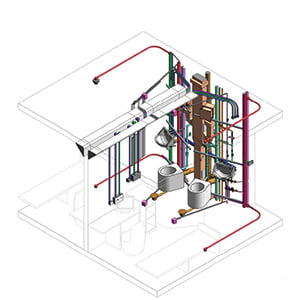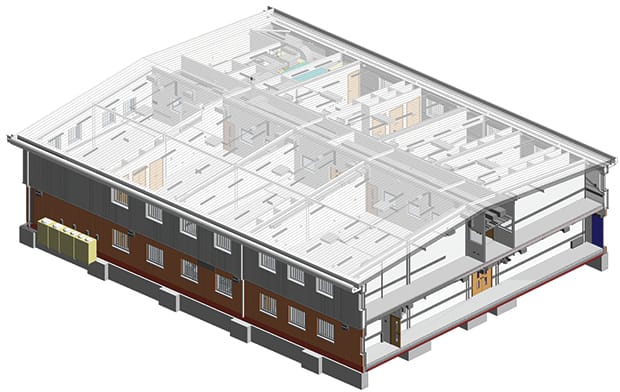Vincent Godfrey, the Ministry of Justice client for the BIM “early adopter” Cookham Wood project, has strongly endorsed the use of BIM on public sector projects – but only for those schemes that are large and complex enough to justify it.
Godfrey’s stance contrasts with the Cabinet Office’s current position on Level 2 BIM, which is that it should be adopted on all public sector projects from 2016, with no minimum size or value threshold.
The MoJ director of procurement also believes that it is possible to “overdo” BIM, and that clients’ teams need to think carefully about what they want to achieve rather than pursuing “BIM for the sake of BIM”.
But Godfrey, whose role at the MoJ covers the procurement of everything from “whole prisons to sheets and mattresses” strongly endorses the use of BIM on the MoJ’s “operationally complex” prisons and courts. Currently, his team is preparing to tender the largest-ever BIM project in the UK public sector – the £250m super prison in Wrexham, north Wales.

“At the MoJ, there’s a clear cut case, so why wouldn’t you use BIM? But at the lower end of the spectrum, for common or garden projects, it might be overkill.”
Vincent Godfrey, MoJ
As a client, he stressed BIM’s ability to deliver better-designed, more efficient buildings over the construction and design efficiencies. “It enables you to bring together lots of different sources of information and to play around with different ideas of what you’re going to build. Intuitively, it does all the right things – BIM isn’t a hard sell. In terms of use of space and subsequent FM considerations, you’re able to have a lot more certainty.”
“The model is not a one-off – we envisage it as a body of knowledge about the building going forward. You can even use it to better manage existing projects. Given that we manage very big, complex buildings, you can see it might have applications on that.”
But he added: “For projects that are operationally complex and multi-faceted, like an MoD base, you can clearly see the case for BIM. Also, on these projects it tends to be the more sophisticated end of the construction industry using it.
“But in more simple cases… you might get people doing BIM for the sake of it. At the MoJ, there’s a clear cut case, so why wouldn’t you use BIM? But at the lower end of the spectrum, for common or garden projects, it might be overkill.”
Asked if he thought there was a minimum value threshold below which BIM should not apply, he said: “It’s not necessarily about the value, it’s about the complexity of construction and in use.”
And speaking generally about BIM, Godfrey questioned the view that releasing its efficiencies requires the involvement of every member of the supply chain. “I don’t think you need to go down to Tier 3 and 4 – it suffices to work with the main design disciplines and the contractors. You can overdo BIM.”
Cookham Wood Young Offenders Institution, in Rochester, Kent, was completed by contractor Interserve earlier this year after after a 44-week contract, reduced from a projected 50 weeks.
It achieved an outturn cost 20% lower than the benchmark for comparable projects, at £2,332 per sq m compared to £2,910. £800,000 of savings were attributed to BIM, with others linked to early selection of Tier 2 subcontractors, and shortening the programme thanks to offsite cell construction. Cookham Wood, designed by HLN Architects, also trialled Two Stage Open Book procurement, project bank accounts and Soft Landings.


Top: Indicative schematic of a pair of cells. Above: a typical block at Wrexham
A report on the project compiled by project mentor David Mosey said that its BIM innovations included the “development by Arup and EMCOR of a model for service ducts and cell risers as MoJ had to be satisfied that they could be serviced by repair and maintenance engineers without reference to a computer.”
The forthcoming Wrexham project would take BIM modelling “to a new level”, Godfrey said, although he declined to put a figure on the savings that could be achieved. “We are about to go out to a competitive tender process and we’re looking for the contractors to come in and offer innovations.” The contractors in line for the role are all part of the MOJ’s national Strategic Alliance framework, namely Balfour Beatty, Interserve, ISG, Lend Lease, Kier and Vinci.
Godfrey added that BIM was now central to its choice of contractors to work with. “When we selected this generation of Strategic Alliance partners [in April 2012], we made sure that we had a good fit, and the next selection round [due to start in 2016] will reflect capabilities in BIM and where we’re at.”
Likewise, BIM is now part of the offer in the MoJ’s consultancy arm, Justice Solutions International. A new social enterprise that reinvests any profits back into the justice system, it will offer foreign countries a range of justice services including advice on prison estates, prison design, prison building and procurement.
“We are very experienced in private finance in prisons, and we are the experts – other than the Americans – in contracting for and running private prisons. We will be advising on every facet of what we do, including finance and BIM.”
See January’s edition of Construction Manager for more on our interview with Vincent Godfrey.











